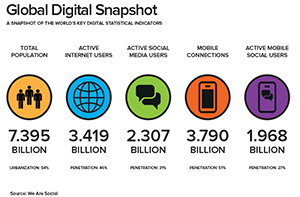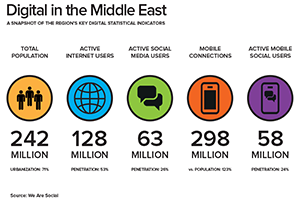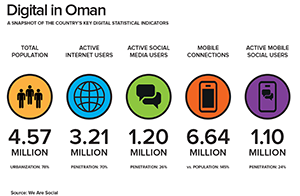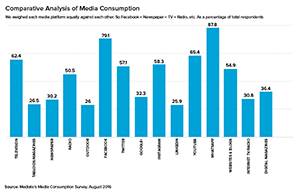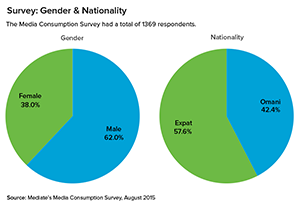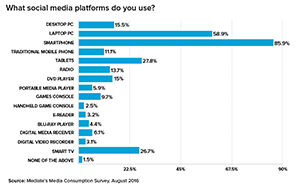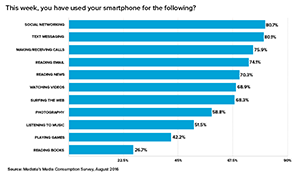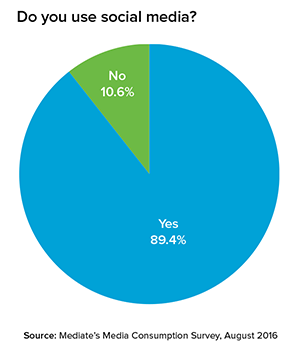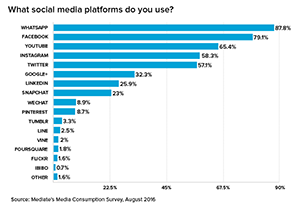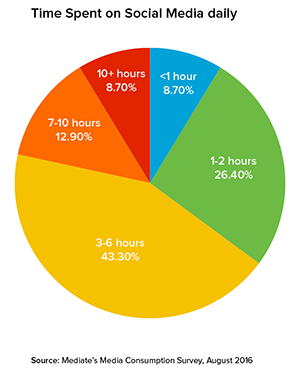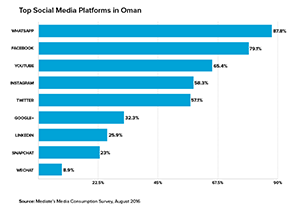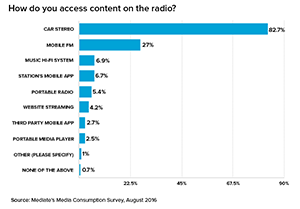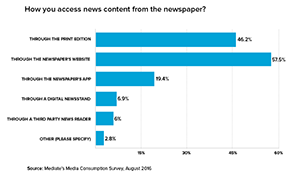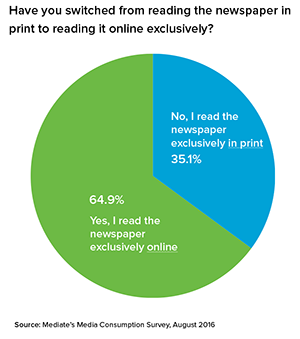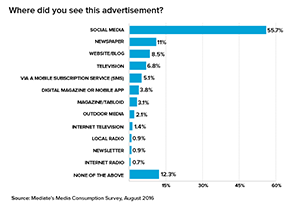Nimble and agile – the new world
Digital and social have emerged as a strong and competitive medium challenging the dominance of traditional players forcing clients, media and agencies to rethink, adapt and change for their own survival. A Mediate report
Digital and social are the two words that are proving to be game changers of the media scene in Oman and the reasons for this are apparent. Firstly, mobile is dramatically changing everything. Smartphones aren’t just a more convenient way to access the internet, they are changing people’s fundamental connected behavior. Secondly, connectivity is becoming the norm with more than half of the world’s adult population using the internet, and well over one-third using social media at least once a month. People now expect everything to be connected. The internet is no longer just an information portal; it’s the fuel of modern society and commerce. Thirdly, for most people, social is (once again) about conversations and it is quickly returning to what it has always been for human beings: connecting on a personal basis with the people we care about most.
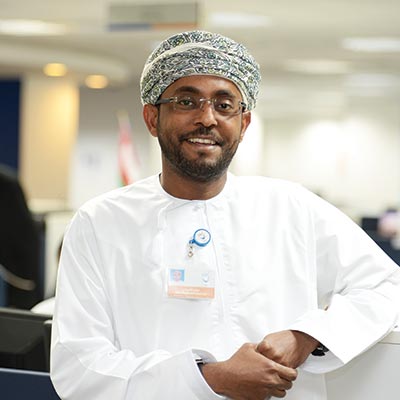
Haitham Al Kharusi
Vice-President of Consumer, Oman Telecommunications Company
These fundamental changes are forcing advertisers, marketers and the media to change and adapt in various ways. Businesses and brands are exploring how connectivity can improve every element of their business, not just their advertising. Success is no longer just about a website or a mobile web presence, but all about optimising one’s entire organisation for a mobile-centric world. For organisations and brands to succeed in this more personal environment, marketers will need to get adept at listening to people and understanding what they want, and not simply use social media as a way to say what they want to convey in new ways. The truth is, brands have to become truly social brands – and not just brands that interrupt people when they’re socialising with each other.
Oman’s media landscape is undergoing a fundamental shift as a result of changing conventions. The Sultanate may not be at the top end of the digital and social media usage matrix, but it is catching up fast. According to We Are Social’s 2016 Digital Yearbook, out of a population of 4.57 million, Oman has 3.21 million active internet users – a penetration of 70 per cent. Of this, 1.2 million are active social media users and with Oman’s young demographic and better connectivity, this number is set to grow.
New media
“Traditionally in Oman, media has been consumed through traditional channels and one would see people buying newspapers and other types of media related to daily news at petrol stations and other outlets,” says Haitham Abdullah Al Kharusi, Vice President, Consumer Business Unit, Omantel. “Over time, this has evolved and a number of media entities have gone online and Oman has adopted that predominately by having a faster growth in the mobile data segment than in fixed broadband.” One big reason why mobile data has trumped fixed is because it is more difficult to reach people in Oman than in other countries. The geographical terrain of the country makes Oman the second-most costly place to deploy infrastructure after Switzerland in the world.
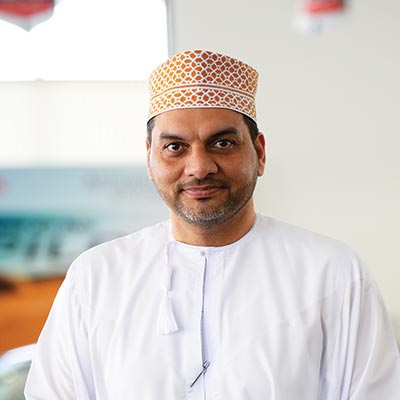
Hussain Al Lawati
Managing Director, Oman Marketing & Services Co. (OMASCO)
Media and news consumption patterns have moved rapidly from traditional channels to broadband to social media in the last few years. This change has had a far reaching impact on the media business. Brands and companies which used traditional media options like newspapers have started relying more on social media. “A large part of what we are spending is going onto the digital platform,” says Al Kharusi. “Earlier we would give half page ads and so on but now we have moved onto the small screen, so that we are intrusively in the face of consumers whether it is through mobile phones, tablets or desktop computers. Advertising and spends have followed consumers to where they are.”
The trend is corroborated by others. Hussain Al Lawati, Managing Director, Oman Marketing & Services Co. (OMASCO) says: “Digital and social are everywhere and it is evolving. You had Facebook, Instagram and Twitter till yesterday, but today you have Pinterest, Snapchat etc. and new platforms that are not here and are coming, video content and YouTube is becoming more important. For youngsters social media is the medium. Our spends are moving in that direction, whether it is going to be 80-20 or 70-30, that depends on various factors.”
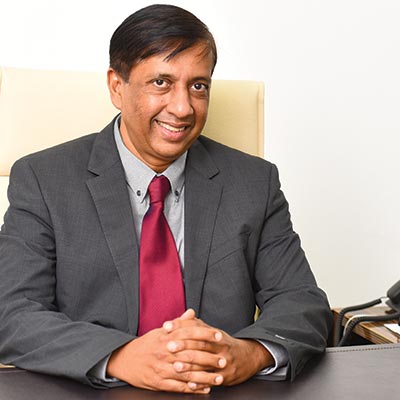
Rajesh Raman
CEO, Hadath International Group
Mazin Al Raisi, Senior AGM of Marketing and Customer Experience, Bank Sohar adds: “Bank Sohar is allocating a decent sized portion of its budget to digital and social media channels. The percentage varies annually depending on the results we are achieving through those channels. Given their popularity and current growth trend, there is little doubt that digital communication platforms will overtake traditional media channels in the coming years.”
The measurability of digital and social media has also caught the attention of advertisers. For instance, while one may know how many people are reading a newspaper, clients are not aware of how many people are seeing their ad, but with digital statistics show how many people are looking and clicking on an advertisement and adding value. Marlen Penner, Head of Digital, TBWA\Zeenah\Digital, says: “While earlier people digital was a side point, now people say, we definitely need print and we definitely need digital.”
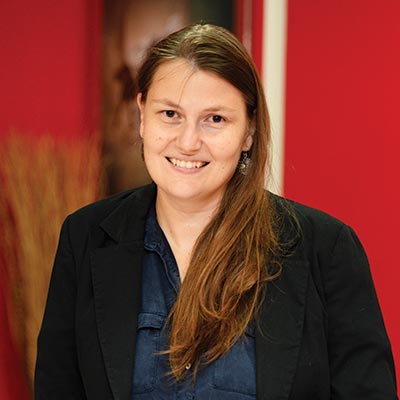
Marlen Penner
Head of Digital, TBWA\Zeenah\Digital
The growth of social media remains unquestionable, but there are doubts about the efficacy of advertising on social platforms for a variety of reasons, including changing behaviours. If Facebook was very effective two to three years ago, today Instagram, Snapchat and WhatsApp are challenging its dominance. It is also difficult to get a person to click through and go to an ad on the small screen as it is seen as an intrusion by most consumers. Finally, though there are metrics for social and digital media, calculating return on investment remains difficult. Given these challenges, big players usually opt for the safest bet. “Almost 50 per cent of our digital budget goes into Google as they have an experienced and deep understanding of consumer behaviour,” says Al Kharusi. As of now clients are focusing their advertising on Facebook, Instagram, YouTube and Google banners.
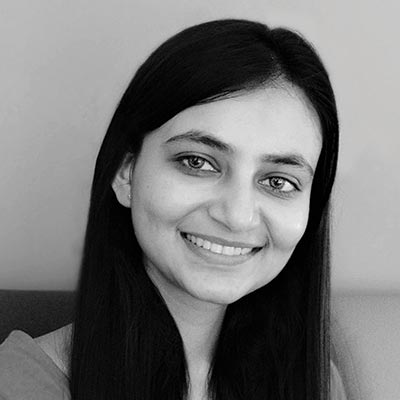
Adveta Dwivedi
Head of Digital, Whoopey.com
Despite these developments Oman still has the potential to try Google Search Advertising and other programmatic approaches to advertising. Inadequate spends and lack of analysis about the relative strengths of mediums has led to limited digital options. Getting the right talent is another challenge and analysts believe that there is a case for incorporating digital as part of the core curriculum in colleges and universities.
Content driven marketing
Aware of the limitations of digital advertising that influence customers, companies are looking at content driven marketing. There is a growing realisation that content is the most important part of digital advertising and clients are trying out making their own branded content in the form of videos, posts and creative campaigns. There is also a huge opportunity for advertisers to personalise their message and make it far more relevant for its target audience on new media. While agencies would segregate consumers demographically by status and income, today, there is an opportunity to separate them psychographically, so if someone is interested in golf, he can be targeted according to the places that he frequents and this is a very powerful tool which agencies and clients can use.
Adveta Dwivedi, Head of Digital at Whoopey.com, an e-commerce company, and a Google-certified digital professional says: “Native advertising works with a model which have publishers and advertisers. Oman has yet not seen many publishers which makes it hard for the advertisers to approach this form of advertising. Banner ads are still big in their offerings to the market. Even publishers have adopted this approach which includes the likes of Sablat and Times of Oman. This has been a popular approach till now but with time we will witness more and more publishers taking up native advertising approach as well.”
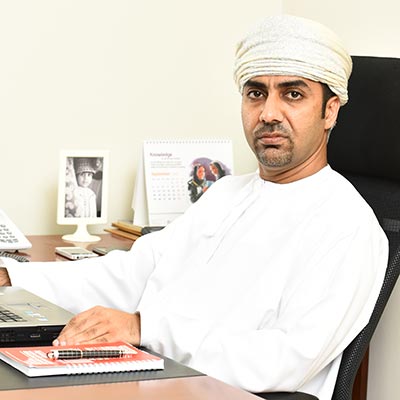
Mazin Al Raisi
Senior AGM of Marketing and Customer Experience, Bank Sohar
Penner adds: “It used to be all about likes and followers four years ago, but there has been a shift, there has been an increase in the need for good analytics and a need for understanding as to what people are saying not just on your channel but also about your brand outside your channels, and that is something that every agency should concentrate on. It is important to understand who your influencers are and how they can help you and your performance.”
Every brand has a personality and every message on social or digital media has to be in line with it. In Oman the larger companies have well-defined brand guidelines. This assumes importance in the new milieu. Once, brands would speak to clients and customers through advertisements and PR in a one-way communication. Now, however, customers respond to messages via social media and it is a two-way street. “Companies should be responsible to some degree for the content that they create, but managing how and where to put it should be left to professionals. Companies are taking charge of what to say, but how to say it is a role that should be left to professionals,” Rajesh Raman, the CEO of Hadath International Group, says.
Hashar Al Mandhari, the CEO of Alamah Marketing, says: “To handle social and digital media one needs to have a good understanding of the brand along with robust technical capabilities. In every sector there are companies that are good with social media, but I would say telecom players started the trend. On social media in many cases the government is better than even some of the biggest companies in Oman, as they have invested in social media and have trained social media teams.” Others, like Penner, disagree. “It is usually the private companies whichare more digitally savvy, government departments are not just slow in their internal processes but also in the way they perceive digital, so it is on the backburner.”
Affordability and the “do it on your own” nature of digital and social is also attracting small and medium enterprises. “SMEs rely more on digital and social media, as it is more cost effective compared to radio, print and outdoor,” says Jessica Asher, the Founder and Solutions Provider at Socioholics. “The larger companies are hesitant to spend on digital media, but the smaller companies are more open to spending on digital and social media, as it is largely about the generation mix and most SMEs are run by young entrepreneurs.”
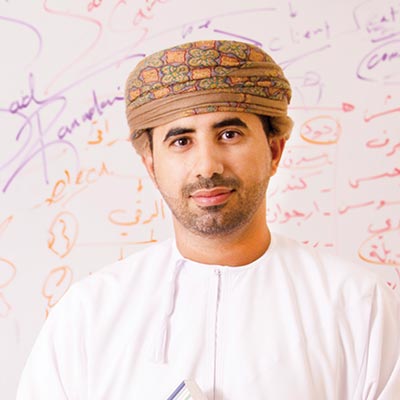
Hashar Al Mandhari
CEO, Alamah Marketing
While digital has come of age in Oman, it still has a fair distance to go and there are a few trends that every company needs heed. One, it is important to collect as much data as possible from consumers to make one’s own data. It is evident that Facebook advertising is becoming more convincing for marketers based on their ability to provide first party data in advertising. It is important to collect one’s own data as well as those based on consumer interactions with your brand. There are several tools like Hootsuite that can help in such efforts. The more customised and personalised message that a brand can give to its audience, the more impact its campaigns will have.
Secondly, the likes of Instagram videos, animated GIFs, branded video content, live streaming, customer testimonials and tutorial/demonstration videos are among the most hyped video content on social media and the web. Videos have become an integral part of digital marketing and today, brands should have a separate budget and video strategy. The other question that comes into the picture is short versus long videos. Short videos have the lead over long videos as many consumersare short on time. Thus, it is imperative to have videos that are short, engaging and contain shareable, viral content.
Finally, smartphones are the most talked about medium for people. Being connected 24/7, online users spend a good amount of time on this medium. Most websites get more than 60 to 70 per cent of their traffic from mobile. Companies need to integrate their strategies keeping mobile in mind. Companies cannot succeed on online mediums if they do not think in terms of mobile first.
The precipitous decline in oil prices over the past two years has been the biggest reason for a fall in advertising budgets, according to Mediate’s Media Marketing Survey. As companies struggle to balance their books, marcom budgets are usually the first ones to get slashed. “Our media spends have been affected by the decline in oil prices,” says Al Lawati. “We concentrate our advertising spends based on seasons and launches.”
Al Raisi echoes this sentiment: “As with other organisations, we are also taking a prudent approach towards advertising. We are more focused towards increasing the efficiency, effectiveness and reach of ads rather than their frequency. As a result, we are being very selective when it comes to the media channels and publications that we partner with.”
It is natural that an economic slowdown would force organisations to closely scrutinise their expenditures across all departments, both internal and external. The challenge for companies is to attain the best possible visibility with realistic budgets. “Therefore, we depend on careful negotiations with our various media channels to obtain the best possible visibility to cost ratio, while at the same time creating a mutually beneficial environment for both parties,” adds Al Raisi. However, Nicolas Labban, general manager, Havas Worldwide, Muscat, says: ”While rumours and reputation reflect a negative impression about the market situation, talking about spends in general, there was a drop but it was less than what was speculated by the market.”
Role of agencies
In a world where Twitter is touted as the first draft of history and WhatsApp is the fastest medium for disseminating news, it is no longer business as usual for advertising agencies. It is imperative for agencies to understand and know how to use these mediums well, in the absence of which they risk obliteration. Gone are the days when agencies could present solutions to clients as quarter or half-page layouts and quite a few of them have been slow to catch on. “Agencies are being run by people who learnt their trade in the last century and there is a need for young fresh minds, especially in advertising, and that is the biggest problem. You don’t go to your traditional advertising agency, whose only interest is to put out their work in the market. Clients have to entrust their media budget to professionally qualified media agencies. Moreover, they need to further split and give the new age or digital media business to specialist digital agencies otherwise they will not get value for the money spent,” says Raman.

Nicolas Labban
General Manager, Havas Worldwide, Muscat
Digital media offers a number of advantages over its classic peers – one can do targeted advertising using Google networks or customise the size of an ad based on the device on which it is being seen. Clients or agencies can create rich media personalised content. Thanks to geo-fencing one can speak to a person when he or she is most receptive to your message.
Finally, the measurability of digital media helps as clients can hold an agency responsible for every rial spent. Given these benefits, it is little wonder that digital spends have been eating into the share of print media’s advertising allocation. In certain cases, clients have reduced their print budgets to as low as 50 per cent.
Oman’s market skipped the PC revolution as most people started using their smartphones or mobile devices to go online. Says Labban: “Digital media is taking over, it is widely spread, reaches target audiences fast in a less expensive manner compared to other media and can be accurately measured.”
Given such advantages, the new-age medium is nowadays the most sought after option by most brands, with clients looking at it in a significantly big way.
Sensing an opportunity in the market, a number of boutique agencies have set up shop to offer specialised services to clients.
Says Al Mandhari: “Overall, you need a human touch in social media, secondly one needs to understand the local community. I see a number of international agencies coming to Oman, but they still bring in their international sensibility without trying to understand the local culture and this is a mistake.”
While such agencies do bring in certain advantages like a focused approach and an ear to the ground sensibility, they evoke a mixed response in the market. “There are boutique agencies and they come by sometimes as we like to support SMEs,” says Al Lawati. They have some good ideas and we have used them on some of our projects. The problem with such agencies is that they are not consistent; they also need to be more creative and think out of the box.”
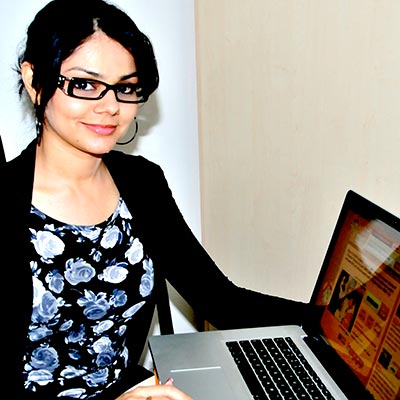
Jessica Asher
Founder & Solutions Provider, Socioholics
Penner adds: “We are aware that some boutique agencies are coming up. These agencies are a threat as in that they push prices down but our offerings stand the test of time. Overall, it is quality over quantity.”
To be fair to boutique agencies, clients often complain about the lack of creativity and exorbitant rates charged by larger agencies. Raman agrees: “The choice of media is changing. It is moving from traditional media to new media; the use of creative technology is changing as people are moving from print to film, video and mobile. There is a need for fresh thinking and approaches in the market.” The good news is that some of this is happening. Some clients aver that the quality of work in the market has improved in the past few years. So while in the past, organisations used to hire agencies from neighbouring countries to handle their marketing communication activities, most of those organisations are now dealing with local agencies; which, in turn, have become more familiar with the country and its social, historical, and cultural elements. Agencies have also garnered a better understanding of the behavioural trends of the local population, which is vital for increasing the quality of communication. Says Al Raisi of Bank Sohar: “As of today, I believe clients are getting good value for the money they spend on such agencies, but as with every field of work, there is always room for improvement.” Increased competitiveness of the market in recent years has also helped in improving the quality of work being provided by ad agencies.
Says Morad Awad – Head, The Agency: “While spending has been affected due to low oil prices, we managed to close 2015 on a positive note. Work is challenging but it is also about diversifying one’s offering and offering smart solutions. Digital is a key word in terms of diversifying. Classically, digital was not a part of an advertising agency’s offerings, but a number of agencies are entering this arena.”
Catching up
The growth of digital/social and the prevailing economic situation has come as a double whammy for the print media, which has traditionally been the most dominant in attracting advertising spends. The sudden change has left the print media looking askance for solutions. The emergence of digital and social is also impacting the veracity of news. Over the past five years, traditional media has become more fact-based, while the traction of social media platforms has led a change from facts to perception or rumour based news. Says Al Lawati: “The media needs to wake up and smell the coffee. Presently their rates and approach to business is more like selling fruits and vegetables. We don’t go to the bestselling newspapers as they charge a fortune, are arrogant and don’t follow up. Newspapers think that turning their newspapers into a digital format will enable them to survive, but it does not work that way.” Despite naysayers, traditional media channels in Oman continue to remain dominant and will remain so until such times that digital and social media channels overtake them in terms of popularity and audience in the local market. “Newspapers have their value and traditional newspapers are going online and that is important,” says Raman. “Great brands like The New York Times etc have survived as they moved online. If you are not on the digital platform you cannot grow it. It would also be naïve to expect your year one digital revenue to match the year 40 print revenue. If you do not get onto that bus you are sure to lose.” Says Awad: “Despite the growing prevalence of digital, the traditional media is still there and it is not disappearing as yet.”
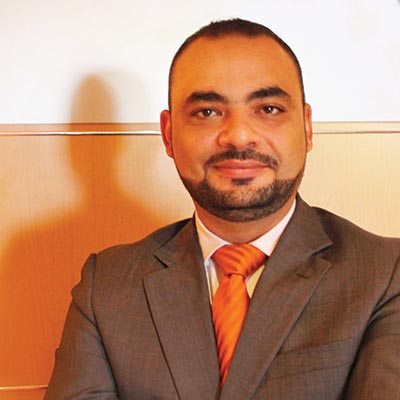
Morad Awad
Head, The Agency
Al Kharusi feels that there is still room for a sustainable business model for traditional media, but it needs to evolve to achieve this. He sees media moving in two directions; one is via big data, which primarily uses the small screen and all the intelligence that comes through it like location-based information. Then there is small data, which is everything that is related uniquely to an individual. Small data is far more effective in encouraging a customer to buy a product compared to big data. “If traditional media is able to take big data and personalise it to find out who a company’s customers are and then deliver small data to them, then it will be on a winning streak,” says Al Kharusi.
The kind of advertisement that happens on the small screen is more effective than other mediums because it is more personalised. “Not many in media understand digital and hence see it as a threat, but if they were to invest some time and understand the purpose and value of digital, the shift would come at a quicker rate than at present,” says Penner.
Ear to the ground
“There is one media that has not deteriorated as much as traditional media and that is radio,” says Al Kharusi. “Radio is still a very significant part of what consumers are paying attention to and consume. This is because people are in transit, they commute in cars from 10 minutes to one hour. Advertising on radio is an important part of our ad spends.” Penner adds: “Radio is growing because we are both visual and sensory and when we listen to something it might stick and when we see that again somewhere it may reinforce the same further.”
Over the past year, radio has been garnering a bigger market share or a share of voice of advertising by eating into traditional media or the print industry. Overall, it is right up there with digital and social media as a preferred choice for advertisers. It is also a more mainstream choice for big organisations while creating their strategic media and advertising plans. According to Eihab Abutaha, the CEO of SABCO Media: “Radio, digital, social and outdoors are key platforms, whereas earlier digital media took a share of print advertising, now radio is a mainstream integrated platform that is interactive and engaging.”
Market watchers agree that there is no one size fits all approach and some media is more relevant than others based on the brand and product. Though private radio is a less than seven-year-old phenomenon, it is still in its infancy and has some way to go to reaching maturity, as a number of clients are still exploring the medium. So while they may be using radio, they are not leveraging it to the maximum extent possible.
The initial clients who started advertising on radio were big companies from sectors like banking, telecom and automobiles. Of late, though restaurants, lifestyle stores, hypermarkets and retailers have joined the fray. Feroz Khan – Director of Sales & Marketing at SABCO Media, says: “Tough economic times have helped radio to grow, clients are not sure about the facts and figures that the print media gives, but they are confident about the reach of radio.”
Radio is also a medium that is in expansion mode. All radio stations have expanded their reach this year. Merge has expanded to Salalah, Buraimi and Nizwa, while Al Wisal has added Dakhliya, the Sharqiya region, Khasab and Buraimi to its reach. Hala and Hi FM has also expanded their geographical reach, going into specific cities, while new radio stations are also expected next year.
The other reasons why radio scores with advertisers is because it is tactical, and advertising spots translate into a sale.
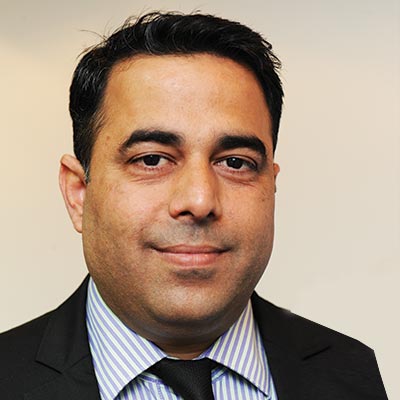
Feroz Khan
Director of Sales & Marketing – SABCO Media
“Radio is closer to the grassroots level of sales as an industry, it is engaging and closer to customers and can manipulate a customer through engagement on a daily basis,” says Abutaha.
“Radio can also do brand building, but the messaging has to be different.” Khan adds: “Most distributors in Oman are not very well supported by their principals so they engage by doing tactical campaigns. As cars on the road are increasing, there is more traffic and advertisers are getting a better response by advertising on radio.”
Looking ahead, the prospects of radio look good as it is a growing business and the familiarity and maturity of clients about using radio is also growing. Till now people have been cautious, using tried and tested approaches, but analysts are confident that there will be more innovation on radio in the future.
Outdoors, or out of home advertising, is another medium that is growing rapidly and holds a lot of potential. Though for it to actualise its potential it needs to overcome a few challenges. Says Awad: “Outdoor is very important for visibility of a brand. Everyone goes out at some point of time and that is when you come across outdoor. Overall, outdoors is a bit shy in Oman. The formats here may need to evolve, we see new formats coming, but it is an area that still needs to evolve.” The geographical spread of the country is another challenge. “Outdoors in Oman are for the big brands because it is expensive and limited. Oman is a country with vast areas and in order to cover intensively any area with enough outdoor units costs a lot,” adds Nicholas.
Different strokes
While the Public Relations (PR) industry has made strides in the past five years, it is still in a nascent stage in Oman. Like any other business, it is client driven –there are those who strongly believe in its value and others who feel it should be part of a bigger marketing strategy. And unlike other markets, it does not have a strong standing of its own. A number of companies understand that brand building and brand awareness are the most valuable assets, while there are others who may believe in it but are not inclined to invest commensurately. Broadly speaking, clients still do not acknowledge the full value of PR, as they feel that the return on investment cannot be quantified like other marketing strategies. Thus, the bias is more towards factual gains that consumer opinion.
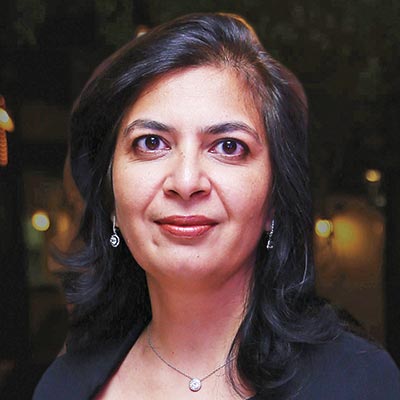
Kavita Pandit
PR & Communications Director, Creative Communications Advertising & Marketing LLC
Says Kavita Pandit, PR & Communications Director at Creative Communications Advertising & Marketing: “Our agency has a mixed bag of clientele – some who specifically ask for PR, others who would rather go the traditional way with print advertising, radio and outdoor advertising and still others who only want to be on social media. A lot of companies are using an integrated marketing approach that includes PR, social media and digital marketing – the percentage dedicated to each segment may vary depending on the services the company offers and target audience. For social media, Facebook, Instagram, Twitter, LinkedIn and Snapchat are platforms that are popular. There are others who are aware of and willing to pay for CIS (customer interface screens) and cinema advertising.”
In recent years, there has not been a marked increase in allocation on digital but within a set budget, the discerning client wants more services through a variety of avenues. “We get to see a harmonious mix in Oman between traditional and new media. However, traditional marketing is more of a one-way communication system focusing on brand building and is more expensive. On the other hand, social media, if done right, is an engaging, interactive, informal communication with almost instantaneous results. That does not necessarily make one better than the other nor can one be ignored over the other. We can already see steps being taken to blend the old with the new,” says Pandit.
Taking a beating
As new venues emerge and Oman is promoted as a MICE destination, events as a medium holds a lot of potential. The Oman Convention & Exhibition Centre is expected to be a game changer for the events and conferences business in Oman. Having said that, the business has been affected by the slowdown of the overall economy. Says Akshay Chowdhary, the Director at Light & Shadow Enterprises, says: “Margins are being eroded as companies are facing a crunch and if you have to survive you have to accept the fact that this is the new reality. In order to survive one has to look at a client’s budget and work backwards from there. While a big format show is very satisfying for the audience, and it is about seeing a big star, but Oman cannot sustain such large format events.”
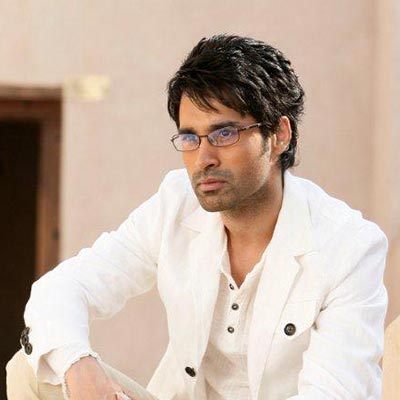
Akshay Chowdhary
Director, Light & Shadow Enterprises
Companies have cut down on corporate events, and scaled things down. This has made it imperative for event companies to innovate. Says Chowdhary: “In the last one year, the events related to corporate companies have been affected. Because of that things have slowed down. But there is
enough work and if you are confident about what you are bringing to the table, then you will get work. There is still a lot of business going around.” Event companies are also using digital and social to promote their offerings in a very big way. The fact that events
is a visual media makes it imperative to be visible on social and digital platforms because if one does not see it, one would not know about it.
Media Consumption Survey
Mediate’s Media Consumption Survey 2016 underscores the growing primacy of social and digital media.
A comparison of various media in Oman shows that WhatsApp is the overwhelming favourite with a weightage of 87.9 per cent, followed by Facebook (79.1 per cent); YouTube (65.4 per cent); television (62.4 per cent); websites (50.5 per cent); radio (50.5 per cent) and newspapers (30.2 per cent). This is a clear indicator of the emergence of social and digital media as a preferred choice for media consumers. The growing penetration of the internet is a key enabler of this trend. Broadband connectivity is growing with 43.8 per cent using fixed broadband and 34.8 per cent being on mobile broadband.
Though traditionally, newspapers have been the first choice for advertisers to connect with potential customers, this premise seems to be under threat. When asked to name the most effective medium to connect with people personally, 64.8 per cent of the respondents cited WhatsApp as the preferred choice followed by Facebook (60.5 per cent); Twitter (41.8 per cent) and newspapers (27.9 per cent). Social media based advertising is also the main driver of purchases as 55.7 per cent of people who bought goods or services saw it on social media compared to 11 per cent in newspapers and 8.5 per cent on websites and blogs. The marginalisation of newspapers is a worrying trend for owners of such titles.
With 85.9 per cent of the adult population owning smartphones, it has emerged as a favoured device for a variety of uses. Smartphones are used for accessing news and information by 81.7 per cent of users followed by 13 per cent on tablets and e-readers and 23.2 per cent on printed hard copy. A large proportion of the population is accessing news and information via social media like Facebook (64.7 per cent), WhatsApp (64 per cent) and Twitter (48.3 per cent) compared to 43.9 per cent who read newspapers. Apart from reading news, smartphones are the overwhelming choice for social networking, text messaging, making and receiving calls and reading emails.
In a notable shift, 64.9 per cent of newspaper readers have moved from reading them in print to reading them online exclusively compared to 35.1 per cent who read the print edition. Moreover, 57.5 per cent of readers access newspaper content using the title’s website compared to 46.2 per cent who use the print edition, while 19.4 per cent use the newspaper’s app.
Social media usage is on a roll with 89.4 per cent of the respondents using one or more social media platforms. In a bit of a role reversal compared to global trends, WhatsApp is the number one social media choice in Oman with 87.8 per cent using it, followed by Facebook (79.1 per cent), YouTube (65.4 per cent), Instagram (58.3 per cent) and Twitter (57.1 per cent). The daily usage of social media is also overwhelming with 43.3 per cent of users spending anywhere between three to six hours on social media; 26.4 per cent spending one to two hours and 12.9 per cent using it for a mindboggling seven to 10 hours. Given such figures, it is hardly surprising that everything from content to advertising is being consumed through such platforms.
Mediate’s Media Consumption Survey reflects the growing pervasiveness of radio. As per the numbers, 58.2 per cent of the population listens to local radio with 47.5 per cent of listeners spending more than 30 minutes everyday on the medium; 29.8 per cent spending more than one hour and 16.5 per cent spending over two hours. As expected 87.4 per cent of people tune in to radio in their car, 82.7 per cent at home, 27 per cent on mobile FM, while 6.7 per cent hear it on the mobile app of radio stations.
Outdoor, or out of home (OOH), cuts a bit of a sorry figure on the survey, with 74 per cent of respondent’s not recollecting seeing outdoor media recently, compared to 26 per cent who saw OOH. Among OOH formats, 54 per cent were noticed at a cinema theatre, while 53.7 per cent noticed billboards and wallscapes. Shopping malls were the number one destination where outdoor advertising was observed with 64.5 per cent seeing one at such places; 48.8 per cent saw them while driving and 39.3 per cent noticed them at the cinemas. Overall, the Mediate Media Consumption Survey proves the emergence of new trends which are challenging and beating entrenched habits and mindsets.
Conclusion
Overall, people and companies are looking at less expensive and more effective solutions from the media and agencies. Budgets have been under pressure and this is expected to continue in the foreseeable future. People need marketing and in tough times probably clients need it more than in good times. So there is a need for smart spending which means knowing what the money spent will achieve. Second, agencies and media need to offer less expensive and more cost-effective solutions that are as effective compared to what they have been using. It is here that digital and social becomes of crucial importance.
Despite drawbacks, various media in Oman are quite effective as they reach audiences efficiently whenever the content is powerful and well thought of. On the other hand, weak content is quickly lost. Advertising and media are closely intertwined as advertising is the creation of the content and ideas, while media is the tool which conveys it to audiences. Finally, given the slump in oil prices and clients’ eagerness to cut budgets, it may be imperative to reiterate the old adage, ‘Advertising and marketing are more critical in tough times than they are in good times’.”
Disclaimer
This article has been collated from IPSOS-STAT data and our informed deductions and analysis. Despite such a fundamentally strong pool of empirical evidence, readers, advertisers, agencies and publishers should use the inferences in this article as a broad guideline, rather than an absolute given. The supporting data used in this article is based on advertising card rates given by companies. As a standard operating practice, media houses offer discounts ranging anywhere between 30 to 50 per cent on these rates and readers can arrive at more realistic figures by doing a back of the envelope calculation.

